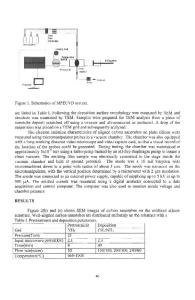Fabrication Of Carbon Nanoribbons Via Chemical Treatment Of Carbon Nanotubes And Their Self-Assembling
- PDF / 6,020,828 Bytes
- 5 Pages / 612 x 792 pts (letter) Page_size
- 56 Downloads / 305 Views
FABRICATION OF CARBON NANORIBBONS VIA CHEMICAL TREATMENT OF CARBON NANOTUBES AND THEIR SELF-ASSEMBLING. P. Y. Arquieta Guillén1, Edgar de Casas Ortiz1, Oxana Kharissova1,2. 1.- Facultad de Ciencias Físico-Matemáticas de la Universidad Autónoma de Nuevo León 2.- Centro de Investigación, Innovación y Desarrollo en Ingeniería y Tecnología. Nuevo León (CIIDIT) ABSTRACT Some potential applications of the nanoribbons and nanorods occur in the medical field, using gold nanoribbon therapies against cancer cells because they have absorption in the near infrared region. In this paper, the nanoribbons were obtained by physical-chemical method based on multilayer carbon nanotubes functionalized with carboxylic radical groups (-COOH). The obtained material was characterized by Scanning Transmission Electron Microscopy (STEM) and Infrared Spectroscopy (FTIR). The obtained nanoribbons have a diameter of 320 nm with preferably 126° angle in their morphology. Keywords: nanoribbons, multi-wall carbon nanotubes, self-assembly. INTRODUCTION According to previous investigations,1-5 it is known that the graphene is a monolayer combination of carbon atoms in hexagonal cells, and that it’s possible to obtain it by chemical treatment of carbon nanotubes. The methodology consists of opening a nanotube to obtain a layer of graphene with a rectangular shape. This rectangular-shaped layer of nanomaterials is called “nanoribbon”. The morphology of a nanoribbon is described in the Fig. 1, and this is a semiconductor material with optoelectronic properties that are capabile of varying depending the size of themselves. In this structure, we can observe the behavior of polarity that this materials normally shows.
Fig. 1. The structure of a nanoribbon (for print version: left color is blue, right is red). The purpose of this work was the obtaining carbon-based nanoribbons by using a chemical treatment on a multiwall carbon nanotubes functionalized with radical groups. The method consists in opening and unrolling a nanotube to obtain the nanoribbon. Its main applications are the future display technology, because its reflectivity can be varied by changing the orientation by applying an electric field, and its application in micro electromechanical systems (MEMS). The nanoribbons and some other metal nanoparticles are being used as teragnostic agents due to the absorption feature in the near infrared and
heat energy given off when excited by infrared light, a property that has allowed them to be used in cancer therapy, because they act directly on the damaged cells do not create collateral damage.6-12 They are based on semiconductor materials and metals that exhibit conductivity. EXPERIMENTAL In the synthesis processes, we used 20 ml of nitric acid (HNO3), 1 g of multilayer carbon nanotubes (MWCNT), 40 ml of sulfuric acid (H2SO4), 3 grams of potassium permanganate (KMnO4), 15 ml of 50% hydrogen peroxide (H2O2) in 40 ml of distilled water, and 100 ml of 10% hydrochloric acid (HCl). The final result has been obtained by chemical treatment without exte
Data Loading...











